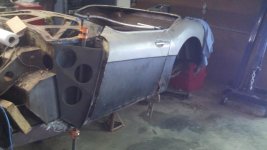hry everybody. I am new to this forum. Hopefully somebody can help me. I started restoring an Austin-Healey 100-6 in 1996. When I got it, the doors where pretty far off fitting; it looked like the car sagged in the middle. I got it all taken apart, got all new outriggers, floors and rockers. My Father started welding the pieces exactly where they where instead of jacking it up in the middle first. Well, I finished the whole car until I got to the doors. They where so far off they couldn't be adjusted. My question is, Do I recut all the outriggers and rockers or cut the car in half and jack it up in the middle until doors fit. Any info would be greatly appreciated. Thanks a lot. huntlu.
-
 Hi Guest!
Hi Guest!
You can help ensure that British Car Forum (BCF) continues to provide a great place to engage in the British car hobby! If you find BCF a beneficial community, please consider supporting our efforts with a subscription.
There are some perks with a member upgrade!**Upgrade Now**
(PS: Subscribers don't see this gawd-aweful banner
Healey Doors
- Thread starter huntlu
- Start date


 smilie in place of the real @
smilie in place of the real @
 Pretty Please - add it to our Events forum(s) and add to the calendar! >>
Pretty Please - add it to our Events forum(s) and add to the calendar! >> 

